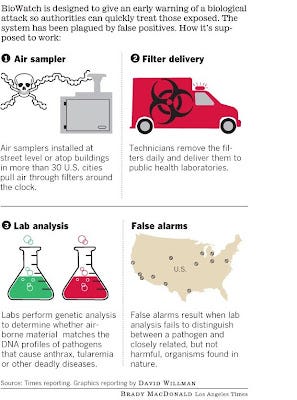"BioWatch" samplers located in subways & atop buildings are defective.

Washington, DC - For two years, the nationwide BioWatch system, intended to protect Americans against a biological attack, operated with defective components that left it unable to detect lethal germs, according to scientists with direct knowledge of the matter.
The federal official who oversaw installation of the components was quietly shifted to a position with no responsibility for BioWatch, and the entire episode was kept out of public view.
The U.S. Department of Homeland Security, which oversees BioWatch, opened an internal investigation, whose status remains confidential.
In more than 30 cities, BioWatch samplers located atop buildings, in train stations and in other public places suck air through dry filters around the clock. Once a day, the filters are taken to public health laboratories to be analyzed for traces of smallpox, anthrax, plague and other pathogens.
Lab technicians extract genetic material from the filters and then use kits, called assays, to release fluorescent dyes into it. When a laser is shined through the mixture, the dyes are supposed to light up if one of the pathogens targeted by BioWatch is present. The labs originally used a series of separate assays, each designed to detect a specific germ. In 2007, Homeland Security equipped most of the labs with new kits intended to screen for multiple pathogens at the same time.
The aim was to reduce personnel costs and enable faster detection of a biological attack, and thus a speedier response.
But the new components, called "multiplex" assays, triggered false alarms, a recurring problem with BioWatch since the system was put into operation nationwide in 2003.
After scientists at many of the labs voiced concerns, Homeland Security officials, in consultation with microbiologists from other federal agencies, ordered testing of the new assays.
The tests, conducted in secrecy at the Pacific Northwest National Laboratory in Washington state and the federal Centers for Disease Control and Prevention in Atlanta, found that the kits were unsuitable for BioWatch, scientists familiar with the matter said. They spoke on condition of anonymity, citing the sensitivity of the information.
The multiplex assays could not distinguish between the bacterium that causes tularemia, a potentially deadly condition also known as rabbit fever, and similar but benign organisms called "near neighbors" that are abundant in outdoor environments. The original assays had exhibited the same problem. But the multiplex assays had an additional shortcoming, scientists said: They were found to be far less sensitive to the presence of actual pathogens than Homeland Security officials had presumed.
Some of the scientists familiar with BioWatch said the multiplex assays were put into use without adequate testing to validate their effectiveness.
The assays were designed at the CDC and the Lawrence Livermore National Laboratory and were built to Homeland Security's specifications by a private company, the scientists said.
Richard F. Meyer, a microbiologist who helped develop the multiplex assays while at the CDC and later supervised their installation as a contractor for Homeland Security, defended the kits.
Meyer said the original assays "were past their life cycle and in constant need of repair." Data collected by Livermore scientists, he said, "supported the use of the (new) technology." Meyer acknowledged that he lost his contracting role with Homeland Security because of dissatisfaction over how the multiplex assays performed once installed.
"When you don't agree with those in charge you get pushed aside," he said in an email.
The Los Angeles Times reported in July that BioWatch has been unable to distinguish between dangerous and benign organisms, and that as of 2008, federal agencies had documented 56 false alarms.
In one of those incidents, during the 2008 Democratic National Convention in Denver, BioWatch units signaled the presence of the tularemia bacterium, triggering tense deliberations among local, state and federal officials over what steps should be taken to protect the public.
After follow-up tests found no traces of the germ at the convention site, officials decided not to take emergency measures, and that evening Barack Obama accepted his party's nomination for president on an outdoor stage, as scheduled, before a crowd of more than 80,000 people. Not once have public health officials had enough confidence in a BioWatch alarm to evacuate an area, dispense antibiotics or take any other emergency action.
After considering the potential disruption from false alarms, federal aviation officials shelved plans to install air-sampling units inside the nation's major airports.
http://azdailysun.com/news/national/u-s-biowatch-technology-defective/article_8486933c-422f-5dc1-99fe-e8ecaa47b296.html
http://articles.latimes.com/2012/jul/08/nation/la-na-biowatch-20120708
http://articles.latimes.com/2012/sep/08/nation/la-na-biowatch-20120908
http://homelandsecuritystudies.blogspot.com/
Biowatch & public health surveillance.
Evaluating Systems for the Early Detection of Biological Threats (The National Academies Press)
http://www.nap.edu/openbook.php?record_id=12688


